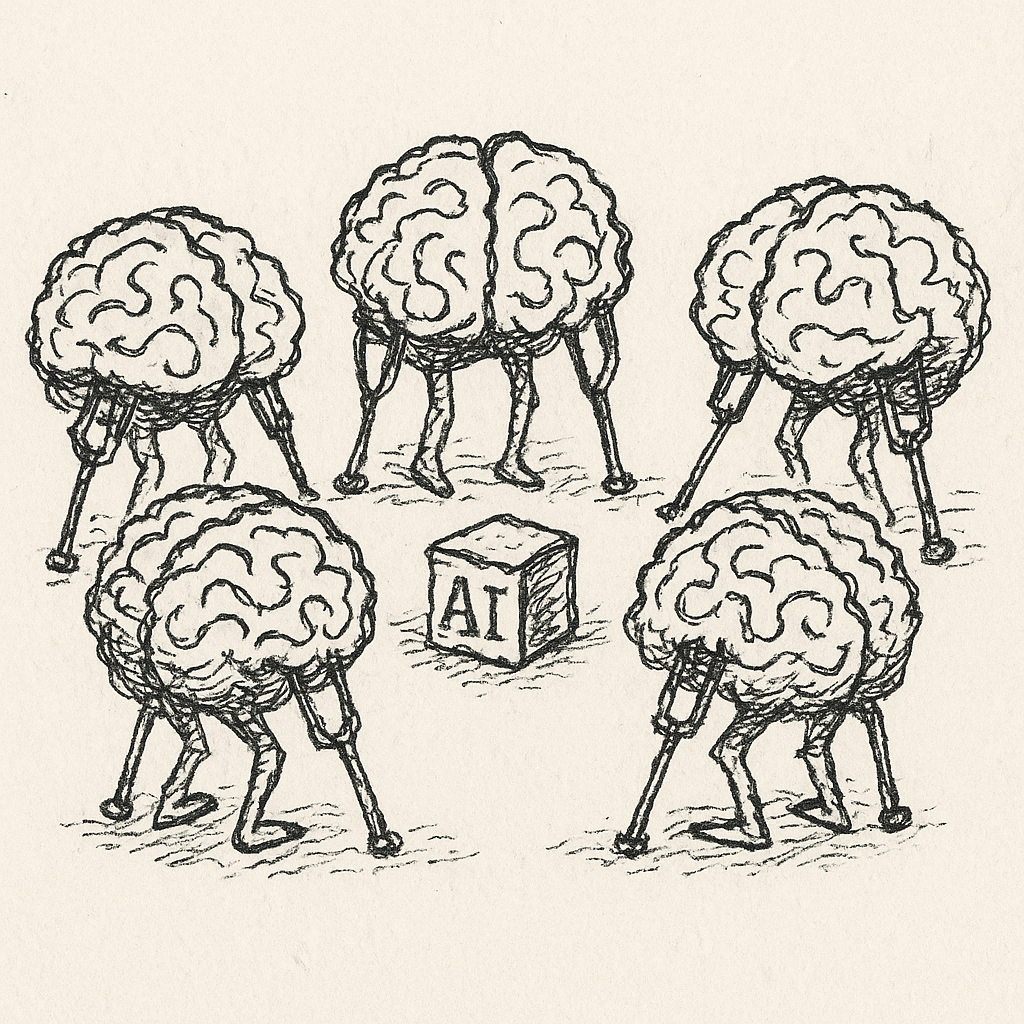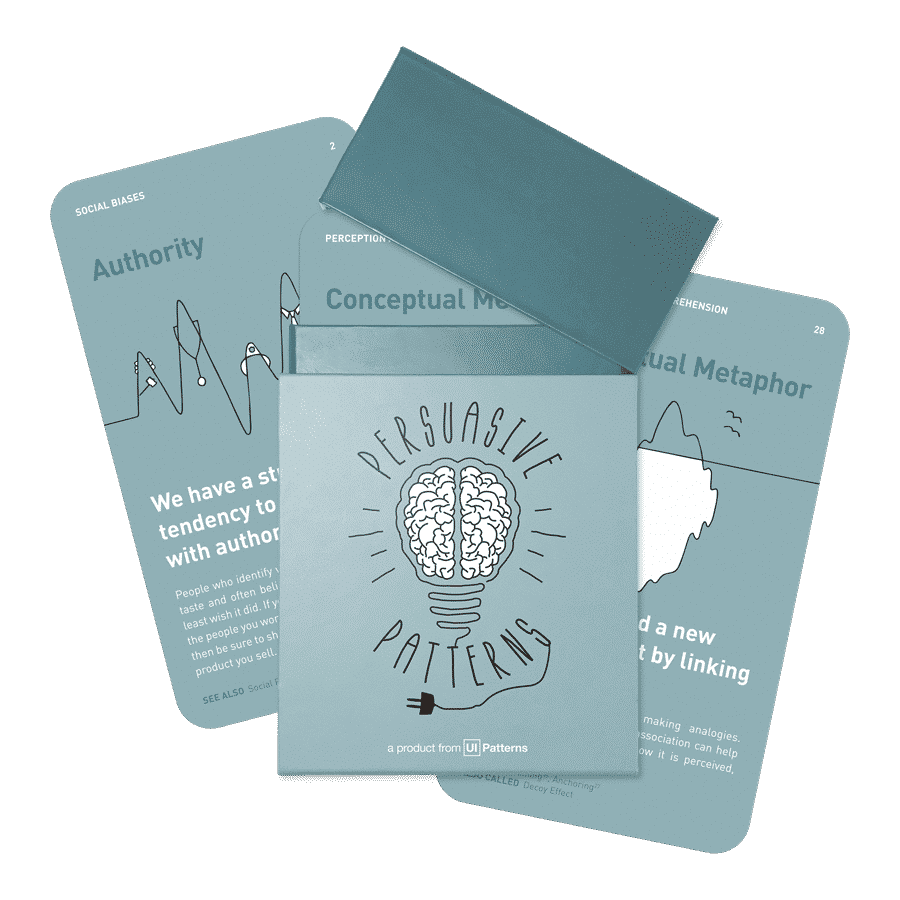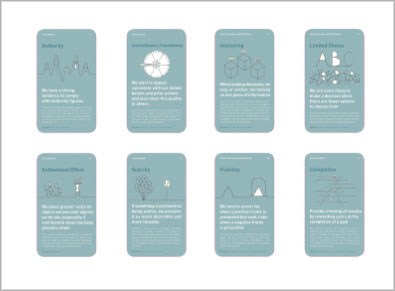Hedging against AI
Why simple card decks keep your brain in the game
Design for behavior change with the Persuasive Patterns card deck
Apply psychological principles to influence decisions, increase engagement, and optimize user experience.
Get your deck!Convenience has a cost.
AI can now draft copy, design wire-frames, and write code in seconds. The appeal is clear: less manual work, faster delivery. Yet studies show that when teams rely too heavily on these tools, critical-thinking scores drop and brain areas tied to memory stay quiet. In other words, every time we let the algorithm “decide,” we miss a chance to practise judgement.
Over-reliance on AI weakens skills and decision-making
The slippery slope of offloading
Psychologists call this cognitive offloading - the moment you hand a thinking task to something outside yourself. GPS killed our sense of direction; now ChatGPT is happy to handle the rest. There’s also the Google effect: we forget facts the minute we know we can look them up. AI amps that up by offering not just facts but conclusions. Less sweat for us, less memory formed, less judgment practised. That trade doesn’t show up in Velocity charts, but it shows up when a feature flops.

Why it matters to product people
Shipping a feature isn’t hard. Shipping a feature that delights users and keeps the business in the black is hard. That requires judgment—balancing risk, bias, and numbers. AI can’t feel the weight of any of that. Hand it the keys and you get speed now, costs later: re-work, support tickets, churn. Good luck sending the bot to the post-mortem.
That balance demands analysis:
- Is the core assumption valid?
- What bias could distort user feedback?
- Which metric matters most to the business model?
AI can surface data, but it cannot feel the weight of trade-offs in your market context. When a team skips that human evaluation, it may launch something that looks promising in a prototype yet fails under real-world constraints. The short-term speed gain then turns into rework, brand damage, or lost revenue—outcomes no algorithm owns, but you do.
The analogue counter-move: pattern decks
Most product teams wrestle with the same four knots:
- we don’t know what users really want,
- we gamble on ideas without proof,
- our designs don’t move people to act, and
- the business model leaks money.
Pattern decks are laser-cut to slice through those knots. Each deck is a stack of proven concepts, tactics, and strategies. They are collections of battle-tested moves you can drop into the problems you are stuck with today.
They’re more than cards: every deck ships with a handful of workshop recipes, complete with step-by-step agendas, canvases, and facilitation tips to get you unstuck immediately. Grab a deck, pick the exercise that fits your problem, and in an hour you’re running a focused session that ends with a concrete next step. No need to invent a process; the toolbox is ready out of the box.
| Deck | What it gives you | Sample workshop you can run today | When to pull it |
|---|---|---|---|
| Validation Patterns | Quick experiments like “Fake Door” or Dry Wallet” to prove, or kill, a bet fast. | “Assumptions Mapping” to focus product experimentation to move your idea forward, faster. | Before burning a sprint on an unverified idea. |
| Discovery Patterns | Field tricks that surface real user pains—think “Concierge,” “Picnic in the Graveyard.” | “Opportunity Solution Tree Mapping” and “Opportunity Scoring” | When you’re guessing instead of knowing and can’t make a move. |
| Persuasive Patterns | Design moves that nudge action—“Endowed Progress,” “Loss Aversion,” “Peak-End Rule.” | “Behavior Scoring” or “Habit Remodeling” | While crafting user flows, copy, or a a sign-up or onboarding process. |
| Business-Model Patterns | Money levers and cost hacks like “Add-ons,” “Bait and Hook”,” or “Fractional Ownership.” | “Business Model Mapping” or “Reimagine Building Blocks” | As you price, package, or pivot. |
| UI Patterns | Proven interface fixes like “Progressive Disclosure,” “Inline Hints,” “Continuous Scrolling.” | “Pattern anotation” and “Onboarding design sprint” | When you need to create friction-free designs that feel familiar with users |
Active learning, where people work out answers themselves, is a proven way to strengthen retention and reasoning. Thinking tools like card decks help bring active learning into product workshops without adding complexity.
Far from being trivial toys, these well-designed brainstorming card decks are purpose-built to strengthen the very skills that AI overuse may weaken. In fact, a review of 155 different card-based design toolkits found that the vast majority were created to facilitate creative thinking and human-centered problem solving (Roy & Warren, 2019). By drawing a card, reading its challenge, and working through ideas with colleagues, product teams engage in a form of guided, active thinking that keeps their cognitive muscles toned. Let’s look at a few key ways these card decks help teams flourish in critical and creative thinking:
- Active problem-solving practice. Card decks demand participation. When a product manager picks a card about, say, “How might cognitive biases be affecting our user experience?”, the team must actively analyze their product through that lens. This mirrors active learning strategies known to improve critical thinking – everyone is applying, evaluating, and creating knowledge, rather than consuming a prefab answer. Such practice in thinking things through end-to-end builds the team’s analytical confidence. Studies show that when people rely less on AI and tackle tasks themselves, they retain stronger critical thinking skills and trust their own judgment more
- Stimulating divergent creativity. AI often reinforces common patterns, but creative card prompts can push teams into new territory. For instance, a “What if…?” card (e.g. “What if our core product feature failed completely?” or “What if a tech giant entered our market tomorrow?”) might ask teams to imagine extreme scenarios, prompting original solutions. Physical tools like these promote divergent thinking, countering AI’s tendency to generate average outputs. Open-ended prompts help teams break habitual thinking and explore more innovative, varied ideas.
- Memory and deep understanding. Teams remember insights better when they generate them together, rather than passively receiving answers from AI. This reflects the generation effect: we retain more when we create ideas ourselves. Card prompts spark discussion, helping teams build shared understanding and mental models. In contrast, AI-delivered solutions are easily forgotten and create less sense of ownership. Card decks keep thinking in human hands, building stronger recall and long-term problem-solving habits.
- Collaborative rational decision-making. Physical cards prompt teams to discuss, debate, and decide together. Each card acts like a mini-facilitator—e.g., “What revenue streams are we not considering?”—pushing the group to think critically, weigh options, and justify choices. This active reasoning builds alignment and uncovers hidden assumptions. Unlike passively accepting AI suggestions, teams engage in shared judgment, strengthening critical thinking and decision-making skills over time.
AI brings speed and support to product development, but overreliance can weaken critical thinking and creativity. Physical card decks provide a simple, effective counterbalance. By prompting teams to slow down, reflect, and collaborate, these tools help maintain human strengths in judgment, reasoning, and innovation. In an age of instant AI answers, choosing to engage with a card prompt signals a commitment to deeper thinking and active learning.
Research shows that teams who generate ideas and solve problems themselves build stronger skills and produce more original solutions. The best product teams will strike a balance—using AI where it helps, but leaning on tools like card decks to keep human insight at the core.
- Roy, R., & Warren, J. P. (2019). Card‑based design tools: A review and analysis of 155 card decks for designers and designing. *Design Studies, 63*, 125–154. https://doi.org/10.1016/j.destud.2019.04.002
- Freeman, S., Eddy, S. L., McDonough, M., Smith, M. K., Okoroafor, N., Jordt, H., & Wenderoth, M. P. (2014). Active learning increases student performance in science, engineering, and mathematics. *Proceedings of the National Academy of Sciences, 111*(23), 8410–8415.
- Mueller, P. A., & Oppenheimer, D. M. (2014). The pen is mightier than the keyboard: Advantages of longhand over laptop note-taking. *Psychological Science, 25*(6), 1159–1168.
- Sparrow, B., Liu, J., & Wegner, D. M. (2011). Google effects on memory: Cognitive consequences of having information at our fingertips. *Science, 333*(6043), 776–778.
- Slamecka, N. J., & Graf, P. (1978). The generation effect: Delineation of a phenomenon. *Journal of Experimental Psychology: Human Learning and Memory, 4*(6), 592–604.
- Park, H., Chen, J., & Gershman, S. J. (2023). Neural correlates of cognitive offloading to language models. *Nature Human Behaviour, 7*, 1451–1460.
- Gerlich, Q. M. (2025). AI tool adoption and the decline of critical thinking in knowledge workers. *Journal of Applied Cognitive Psychology, 39*(2), 162–178.
- Janis, I. L., & Mann, L. (1977). *Decision making: A psychological analysis of conflict, choice, and commitment.* New York, NY: Free Press.
- Logg, J. M., Minson, J. A., & Moore, D. A. (2019). Algorithm appreciation: People prefer algorithmic to human judgment. *Organizational Behavior and Human Decision Processes, 151*, 90–103.
- Sullivan, A., & Kint, M. (2022). Critical thinking as a predictor of product-launch performance. *Journal of Product Innovation Management, 39*(4), 512–528.

